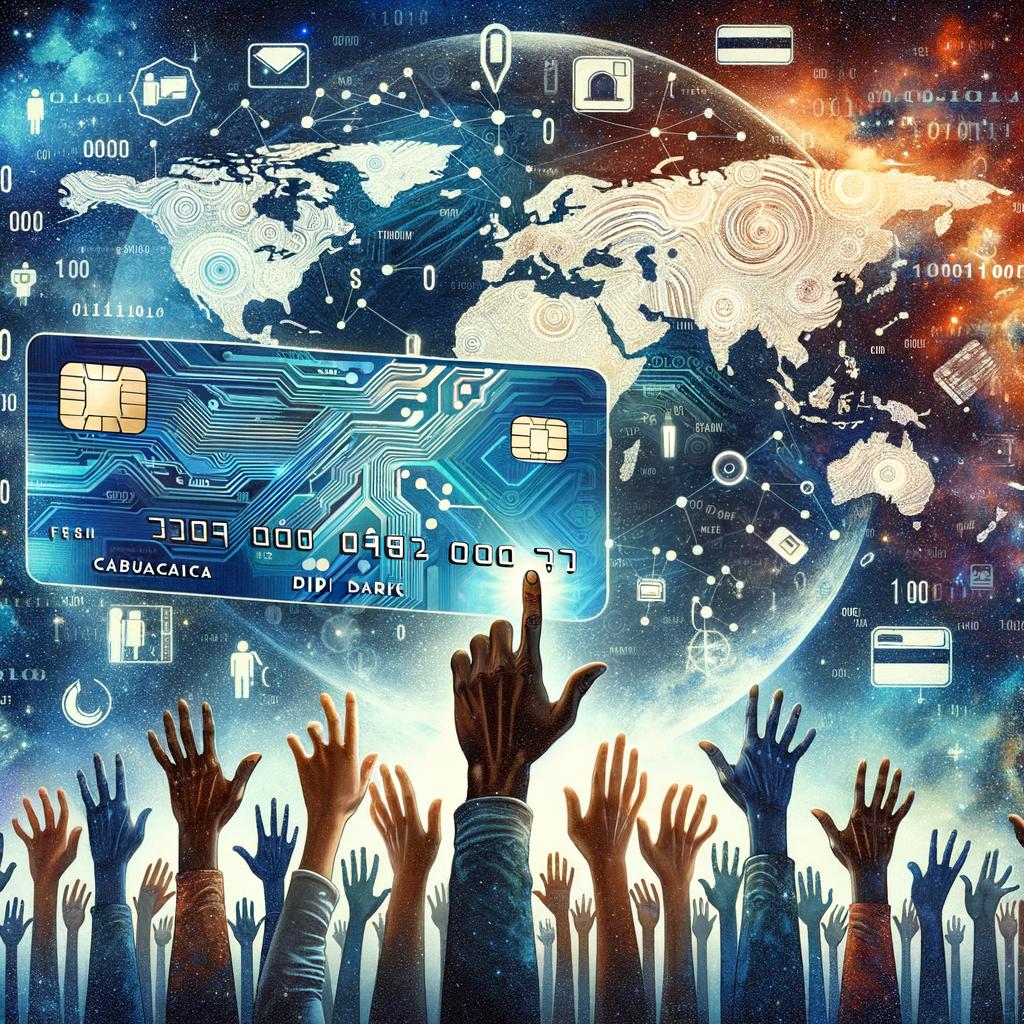In the vast realm of e-commerce, where the virtual world meets cold, hard cash, exist some cunning creatures – the fraudsters. These nefarious beings prowl the dark corners of the internet, waiting for their next unsuspecting victim. But fear not, fellow web warriors! With a little know-how and a pinch of common sense, you can arm yourself with fraud prevention tips that will have these villains shaking in their virtual boots.
First and foremost, let’s talk passwords. We’ve all been guilty of using “password123” at one point or another, right? Well, it’s time to up our game. When creating passwords, we must think like magicians: the more complex, the better. Mix uppercase and lowercase letters, throw in some numbers and symbols, and voilà – you’ve got yourself a strong password that will flummox even the craftiest of hackers.
Now, let’s delve into the treacherous land of phishing emails. These deceitful missives, adorned with shining “deals” and “opportunities,” lurk in our inboxes, just waiting for us to take the bait. Remember, my friends, always be skeptical. If an email seems too good to be true, it probably is. Hover over links to see where they lead before you click, and remain vigilant. Your wallet will thank you.
Next up, let’s talk about that tiny padlock symbol we often overlook. When making an online purchase, always check for the padlock in your browser’s address bar. This little icon signifies that your connection is secure, encrypting your sensitive data from prying eyes. It’s like a superhero cape for your credit card information. So go ahead, don your virtual cape with confidence!
Another cardinal rule for e-commerce safety is to keep your software up to date. Just as you wouldn’t leave a back door unlocked, you shouldn’t leave vulnerabilities in your virtual fortress. Software updates often provide crucial security patches, sealing any loopholes lurking in the shadows. So, embrace those updates like a tech-savvy warrior, keeping your website armor impenetrable.
Of course, what article about fraud prevention would be complete without mentioning that ever-elusive beast – encryption. You’ve heard the term before, but what does it actually mean? Well, think of it as a secret language that only you and the recipient can speak. By encrypting your data, you’re ensuring that sensitive information like credit card details or personal addresses remain hidden from the prying eyes of cybercriminals. So, make sure your website has an SSL certificate, and watch those fraudsters flee in terror.
Lastly, but perhaps most importantly, be a skeptical consumer. Just as you wouldn’t buy a bridge from a stranger, don’t trust every website that comes your way. Research the seller, read reviews, and trust your gut. If something feels off, don’t proceed. Remember: you hold the power in this virtual world, so wield it wisely.
In conclusion, my fellow e-commerce enthusiasts, practice these fraud prevention tips, and you’ll be a force to be reckoned with. Stay tenacious, stay informed, and stay safe out there in the wild west of e-commerce. Together, we can send those fraudsters running, tails between their legs. Happy shopping, my brave web warriors!
International trade has become a whirlwind of exciting opportunities, connecting businesses from different corners of the globe. It’s a beautiful dance where products and services seamlessly cross borders, fostering globalization like never before. However, the backbone of this extravagant affair often goes unnoticed – payment gateways.
Think of payment gateways as the smooth operators of the international trade world. They’re like the charming jewelry store clerk who deftly handles your purchase, making sure you leave with a smile on your face and a heart full of anticipation. These tech-savvy gateways facilitate the transfer of money between buyers and sellers, transcending borders and currencies. Without them, international trade would be a confusing tangle of hurdles and lost opportunities.
Picture this – you’re a small business owner in Bangkok, and you receive an inquiry from a customer in Amsterdam who adores your handcrafted cushions. Eager to make the sale and expand your reach, you want to offer a seamless payment option that fits both your needs and your customer’s preferences. Here’s where payment gateways swoop in like superheroes, saving the day.
With payment gateways, not only can you securely accept payments from Amsterdam, but you can also allow customers from around the world to pay using their preferred method. Whether it’s PayPal, Stripe, or good old credit cards, payment gateways bridge the gap between buyers and sellers, making cross-border transactions as effortless as a stroll on a sandy beach.
But it’s not just about ease. Payment gateways also play a crucial role in protecting both parties in a transaction. Just like a vigilant bouncer who spots fake IDs, these gateways offer robust security measures to safeguard customer information, detect fraud, and prevent data breaches. This way, both sellers and buyers can sleep soundly, knowing that their money is handled with the utmost care.
Now let’s fast forward to the moment where the sale is made, and the payment is on its way to you, the Bangkok business owner. This is where the magic happens. Payment gateways seamlessly convert the customer’s currency into yours, ensuring that you receive the exact amount agreed upon, minus the pesky exchange rate woes. It’s like having a language translator who effortlessly translates every word, allowing commerce to speak a universal tongue.
But wait, there’s more! Payment gateways also assist in the perilous journey of customs duties and taxes. Imagine shipping a box of your finest tea blends to a tea enthusiast in London. Just as your package arrives at the buyer’s doorstep, an unwelcome surprise pops up – a hefty customs duty bill. Before panic sets in, payment gateways step in with their digital superpowers, providing accurate calculations of customs duties, taxes, and any additional charges that come along. It’s like having a trustworthy mentor to guide you through the maze of international regulations.
In conclusion, payment gateways are the unsung heroes of international trade, enabling businesses to effortlessly connect with customers worldwide. With their seamless payment options, robust security measures, currency conversion prowess, and knowledge of customs duties, these gateways make international trade a symphony of joy rather than a cacophony of turmoil. So, let’s raise a glass to these digital maestros, for behind every successful international transaction, there’s a payment gateway making sure the melody stays delightfully harmonious.
Mobile payment solutions have revolutionized the way we handle our financial transactions. Gone are the days of fumbling around for loose change or swiping our credit cards at checkout counters. With just a tap of our fingers, we can now purchase goods and services seamlessly. But while mobile payment solutions have made our lives easier, they have also raised concerns about data protection regulations.
In this digital era, data protection has become a paramount issue. With the increasing number of cyber threats and breaches, it is essential to ensure that our personal and financial information is kept secure. Mobile payment solutions, with their convenience and accessibility, have become a breeding ground for potential uncertainties.
To fully grasp the implications of mobile payment solutions on data protection regulations, we must first understand how they work. These payment solutions utilize near-field communication (NFC) technology, which allows two devices to communicate over short distances. When we tap our mobile phones on a payment terminal, the NFC technology facilitates the transfer of data, completing the transaction.
The concern lies in the security of this data transfer. Hackers and cybercriminals are constantly evolving, using innovative methods to steal sensitive information. With the increase in mobile payment usage, the potential for data breaches is a real and pressing issue. Therefore, it is vital for data protection regulations to adapt and keep up with these emerging technologies.
To address these concerns, several data protection regulations have been put in place. These regulations aim to ensure that consumer data is handled with utmost care and to hold organizations accountable for any breaches or mishandling of information. One such regulation is the General Data Protection Regulation (GDPR), implemented by the European Union. The GDPR mandates organizations to implement strict security measures, obtain explicit consent from users, and provide transparency regarding data handling practices.
Mobile payment solution providers must comply with these regulations and adopt robust security measures to protect user data. Encryption techniques, tokenization, and secure communication protocols are just a few of the measures that can be implemented to mitigate the risk of data breaches. Additionally, adopting a privacy-by-design approach ensures that data protection is embedded within the design and development of mobile payment solutions right from the start.
However, compliance with data protection regulations is not solely the responsibility of the solution providers. Consumers also play a vital role in safeguarding their data. By regularly updating their mobile devices, using strong and unique passwords, and refraining from sharing personal information in insecure networks, they can contribute to the overall protection of their data.
In conclusion, mobile payment solutions have undoubtedly transformed the way we make payments, but this convenience should not come at the expense of data protection. With the ever-evolving landscape of cyber threats, it is imperative for data protection regulations to keep pace with technological advancements. By striking a balance between convenience and security, we can ensure that mobile payment solutions harmoniously fit into data protection regulations, ultimately benefiting both consumers and businesses.
Artificial Intelligence (AI) and Machine Learning (ML) have not only revolutionized various industries but have also transformed the way we shop online, particularly in the realm of payment processing. Gone are the days of mundane payment gateways and countless manual transactions. Thanks to the advancements in AI and ML, e-commerce payment processing has become an effortless and enjoyable experience.
Let’s dive into the exciting role that AI and ML play in the world of online payments. Imagine you’re about to complete your purchase. As you proceed to check out, AI algorithms quickly analyze your browsing history, personal preferences, and shopping patterns. With this vast amount of data at their disposal, AI systems predict which payment options you are most likely to choose.
The AI-powered payment processors also come with fraud detection mechanisms, which have revolutionized online security. These smart systems can analyze every transaction in real-time, spotting irregularities that might indicate fraudulent behavior. Combining this data analysis with historical patterns and machine learning models, AI can accurately determine the probability of a transaction being fraudulent. This not only safeguards consumers but also provides e-commerce platforms with peace of mind.
Moreover, AI and ML have transformed the cumbersome process of manual transaction reconciliation. Previously, businesses had to spend countless hours manually matching payments with orders, leading to human errors and delayed processing times. However, with the advent of AI-powered reconciliation systems, this process is now automated. ML algorithms efficiently cross-reference payment details with purchase records, minimizing errors, and significantly reducing the time required for reconciliation.
One of the most exciting applications of AI and ML in e-commerce payment processing is personalized pricing. Gone are the days of fixed prices for products and services. AI-integrated systems now analyze your browsing behavior, geo-location, and historical purchase data to offer personalized pricing at the individual level. This dynamic pricing strategy provides businesses with a competitive advantage, while customers feel valued and receive exclusive offers tailored to their needs.
Chatbots and virtual assistants have also entered the payment processing arena in an AI-fueled frenzy. With the ability to understand natural language and analyze customer intent, these intelligent assistants can guide users through the payment process seamlessly. They tackle any roadblocks faced during the checkout process, ensuring a positive user experience and increasing conversion rates.
Thanks to AI and ML, e-commerce payment processing has become faster, smarter, and more secure. Buyers can enjoy hassle-free transactions, personalized pricing, and greater confidence in the security of their data. On the other side, businesses benefit from increased efficiency, reduced fraud, and improved customer satisfaction.
The role of AI and ML in e-commerce payment processing is constantly evolving. As technology advances, we can expect more innovative features and enhanced capabilities, further enhancing our online shopping experience. So, the next time you click that “Buy Now” button, remember the invisible AI-powered systems working diligently behind the scenes, making your payment process a breeze.
Navigating the World of Debit Card Limitations and Overdrafts
You’re strolling through the mall, browsing all those amazing sales, and your eyes land on the perfect pair of shoes. You know they’ll complete your collection and instantly boost your style game, so you confidently whip out your debit card, ready to make your purchase. But hold on a moment, my friend! Are you aware that your trusty plastic buddy might have some sneaky limitations and lurking overdraft fees? Don’t worry, we’ve got you covered with some crucial information to keep you on top of your financial game.
First things first, let’s talk about debit card limitations. Picture this: it’s a cozy Sunday morning, and you’re craving a fancy brunch at that new trendy spot everyone’s been raving about. But before you daydream about those delicious eggs benedict, make sure you know your daily spending limit. Many banks set a cap on how much you can spend using your debit card in a day. So, if that limit is lower than the amount you had projected to spend, you might have to put your gastronomical dreams on hold until tomorrow. It’s always a good idea to reach out to your bank and ask about any spending limitations they might have imposed on your card.
Now, here’s where things get a little trickier – overdrafts! Imagine you’re all excited about that limited-edition vinyl record, and you swipe your debit card, all set to rock out to your heart’s content. But wait, what if you don’t have enough funds in your account to cover the purchase? That’s when overdraft fees come barging in, like rude roommates crashing your party. These fees can be a real headache, and they vary from bank to bank. It’s crucial to be aware of your bank’s policies on overdraft charges and how they may impact your precious hard-earned cash. Nobody wants to pay an outrageous fee for buying that catchy tune.
So, how can you avoid these pesky overdraft fees like a seasoned financial ninja? One option is to link your debit card to your savings account or apply for overdraft protection. This means that if you swipe your card and there aren’t enough funds in your checking account, the bank will automatically transfer money from your linked savings account to cover the purchase. However, keep in mind that some banks might still charge you a fee for this service, but it could be significantly lower than the dreaded overdraft punishment.
Another way to steer clear of overdraft madness is by monitoring your account balance like a hawk. Download your bank’s mobile app – nifty piece of technology, really – and check your balance regularly. This way, you can keep track of your spending, catch any discrepancies, and avoid overdrawing your account unintentionally. It’s like being your own financial superhero, but without the cape and the cool gadgets.
Finally, it’s essential to stick to a budget and live within your means. I know, it’s a real buzzkill, but trust me, it’s for your own good. Before splurging on that fancy dinner or the latest tech gadget, take a moment to evaluate your financial situation. Can you afford it without jeopardizing your future financial goals? If not, it might be wiser to save up a bit longer or explore more affordable alternatives. Remember, it’s all about making informed decisions that will keep you sailing smoothly through the vast ocean of financial responsibilities.
So, dear reader, as you step out into the world armed with your debit card, remember to be mindful of its limitations and the potential overdraft booby traps awaiting you. Stay informed, stay vigilant, and stay afloat in the sea of economic adventures. Now, go forth and conquer that shopping spree – only within your financial superpowers, of course!
In the not-so-distant past, shopping involved a series of tedious tasks. From braving the crowded malls to waiting in line at the checkout counters, the thought of running errands seemed like an endless ordeal. But oh, how times have changed! In this digital age, buying and selling has taken an exhilarating turn with the advent of social media payments.
Picture this: you’re scrolling through your newsfeed, catching up on the latest cat videos, when suddenly, you stumble upon an eye-catching ad for a sleek new smartphone. Your heart races, and the temptation to make an impulse purchase is simply too hard to resist. However, you’re hesitant. After all, it’s not often that you come across such amazing deals on social media platforms. But fear not, dear reader, for the era of e-commerce has got you covered!
Gone are the days of rummaging through your wallet, desperately searching for loose change. With social media payments, the power lies at your fingertips – quite literally! By integrating payment gateways into popular platforms like Facebook, Instagram, and TikTok, technology has democratized the art of online shopping, making it accessible to one and all. From trendy fashion pieces to artisanal crafts, every click carries the potential to secure a fantastic purchase.
But how do these payments work, you may ask? Well, let’s dive into the nitty-gritty. When you stumble upon an irresistible item, all it takes is a single tap of your finger to reveal its mesmerizing details. Once you’ve made your decision, a magical button labeled ‘Buy Now’ appears, beckoning you into a realm of possibilities. Here, you can choose your desired size, color, or any other personalization options, just like a real-world store. But the true wonder lies in the simplicity and speed of the payment process.
No longer must you tediously fill out lengthy forms or fumble with your credit card. Social media payments offer a seamless experience, allowing you to link your accounts to your favorite platforms. With just one tap of your preferred digital wallet, be it Apple Pay, Google Wallet, or even cryptocurrency, the transaction is complete. Effortlessly, you glide through the cyber-space, your purchase finalized almost as quickly as your heart skipped a beat at first sight.
But what about security, I hear you whispering at the back of your mind? Well, fear no more, for technology has come to our rescue once again. Social media platforms have cemented their commitment to user safety, employing state-of-the-art security measures that rival those of Fort Knox. Multiple encryptions, two-step verification, and cutting-edge fraud detection mechanisms ensure that your personal information remains safeguarded at all times.
So, dear reader, let us raise a metaphorical glass to the advent of social media payments! In this new era of e-commerce, the power lies with us, the consumers. With just a tap of our finger, we have the ability to indulge in the products we desire, without the hassle and frustration of traditional shopping experiences. So, go forth, explore the digital marketplace, and let the world of social media payments elevate your every online purchase to a whole new level of convenience and delight!
Navigating Per-Transaction Fees and How They Affect Your Business
Hey there, fellow business owners! Today, we’re diving into the thrilling world of per-transaction fees and how they can impact your precious enterprise. We all know that running a business is like sailing a ship through ever-changing financial waters, and understanding these fees is like charting a course to avoid hidden rocks. So, buckle up, because we’re about to embark on this enlightening journey together!
Now, what are per-transaction fees? Well, my friends, they’re those sneaky charges incurred every time a customer waves their magical credit or debit card in your direction. They may seem inconsequential at first, but trust me, they can add up faster than seagulls diving for a tasty scrap! These fees can really affect your bottom line, and as savvy businesspeople, it’s our duty to understand their implications.
Picture this: you run a trendy coffee shop, crafting delicious caffeine concoctions that keep the neighborhood buzzing. Your average sale is a whopping $5 per cup of heaven, and you process about a hundred transactions a day. So, how much are you paying in per-transaction fees? Well, let’s whip out our calculators and do some quick math, shall we?
Assuming your payment processor takes a 2.5% cut from each transaction, you’re dishing out a cool $125 in fees daily! That’s equivalent to 25 cups of your signature brew – and we all know that’s no small chunk of change. Now, multiply that by thirty days in a month, and we’re talking about a staggering $3,750 floating away to those fee-hungry sharks! So grab your life vests, because this can really sink your ship if you’re not careful.
But fret not, intrepid entrepreneurs! There are ways to navigate these perilous seas and minimize the impact of per-transaction fees. First, shop around for payment processors like a thrift-store aficionado seeking the perfect retro jacket. Compare their fees, their reputations, and even their customer service. As the saying goes, “A rising tide lifts all boats,” so don’t be afraid to negotiate and find the best deal out there.
Another nifty trick is to encourage your customers to use alternative payment methods. Poky old credit cards don’t have to be the only option! There’s a whole world of digital wallets and mobile payment apps just waiting to be explored. Not only can these be more convenient for your hipster customer base, but they often come with lower transaction fees, giving your profit margin a much-needed boost.
Furthermore, consider implementing a minimum purchase requirement for card transactions. I know, I know, customers can be touchy about it, but trust me, they’ll understand. A little sign signaling that you kindly ask for a $10 minimum purchase will deter those pesky small transactions that eat up your profits in fees. Plus, it might even increase sales as customers decide to grab that extra muffin to meet the minimum – win-win!
So, dear entrepreneurs, the world of per-transaction fees may seem daunting, but fear not! Armed with these strategies, you can steer clear of those inevitable shoals, keeping your ship afloat and your profit sails full. Remember, knowledge is power, and by understanding these fees, you’ll be navigating those choppy business waters like a seasoned captain. Hoist the anchor, my friends, and may your per-transaction fee voyage be smooth sailing!
In a world fueled by fast-paced transactions and tech-savvy consumers, the concept of fumbling for cash or digging into the depths of your wallet for a credit card seems like a distant memory. Welcome to the era of digital payment solutions, where convenience meets technological ingenuity – all in the palm of your hand.
Gone are the days of carrying bulging wallets filled with an assortment of credit cards, loyalty cards, and crumpled bills. With a simple tap or a flick of your finger, you can make seamless transactions and glide through the checkout line like a digital ninja. Digital payment solutions have revolutionized the way we handle our finances, bringing a whole new meaning to the phrase “money talks.”
Imagine this: you’re sipping on a piping hot cappuccino at your favorite corner café. Rather than interrupting the rhythmic flow of your caffeine fix, you swiftly unlock your smartphone and navigate to your virtual wallet. With a flick of your thumb, you select your preferred digital payment app and voila! The barista, none the wiser, acknowledges your transaction with a covert nod of approval. It’s as if you’ve mastered the art of modern-day sleight of hand.
But how exactly do digital payment solutions work their magic? At their core, these solutions harness the power of a simple mantra: convenience is king. Whether it’s using Near Field Communication (NFC) technology, scanning QR codes, or employing biometric data, these payment methods remove the friction from traditional transactions.
Take NFC technology, for example. Using a small chip embedded within your smartphone or wearables, you can make contactless payments at a variety of retailers. Simply hold your device near the payment terminal, confirm the transaction, and voila! The payment is complete. It’s like playing a high-tech game of tag, only with money instead of playground equipment.
Alternatively, the rise of QR codes has become a phenomenon in many parts of the world. Companies and merchants have embraced the simplicity of QR codes, allowing customers to easily scan a code and proceed with the payment process. It’s a seamless transition from the physical to the digital realm, where a swift snap of your smartphone camera becomes a gateway to financial bliss.
Biometric authentication has also taken center stage in the world of digital payments. With the ability to use fingerprint or facial recognition as forms of identification, the need for passwords and PINs has become all but obsolete. Your unique biological features are now your secret handshake, granting access to your digital assets with a touch or a gaze. It’s a sci-fi dream turned reality, where you can pay for your morning java with nothing more than a wink and a well-placed fingerprint.
Beyond the realm of convenience, digital payment solutions offer a myriad of benefits. Security is paramount in our interconnected world, and these solutions have stepped up their game to protect your hard-earned funds. With encrypted transactions, multi-factor authentication, and real-time fraud detection, you can rest assured that your finances are safeguarded from the clutches of cybercriminals.
Moreover, these solutions empower businesses by streamlining their operations and reducing the reliance on physical cash. From small merchants at local farmers’ markets to multinational corporations, digital payments have spawned a cashless revolution that transcends borders and cultural barriers. It’s a global dance of digits, where money knows no bounds and the world becomes your digital oyster.
So, whether you’re paying for your daily dose of caffeine or splurging on that coveted gadget, digital payment solutions have redefined the way we handle our finances. With unmatched convenience, enhanced security, and a touch of futuristic flair, our wallets have become slim and sleek, devoid of clutter and bursting with possibilities. Welcome to the future of payments, where the only limit is your imagination.
Are you ready to embark on your next adventure abroad? Whether you’re planning to sip margaritas on a sandy beach or explore the bustling streets of a foreign city, one thing is for certain: you’ll need some moolah to fuel your escapades. But fret not, fellow wanderluster! Gone are the days of clunky traveler’s checks and fumbling with foreign currency. In today’s cashless world, credit and debit cards have become our trusty companions, and they’re here to save the day, no matter where your journey takes you.
First things first: it’s crucial to inform your card provider about your gallivanting plans. Picture this: you’re enjoying a delicious gelato in Rome, and suddenly, your card stops working. Disaster strikes! So, before you hop on that plane, take a moment to notify your bank of your whereabouts. Trust me, they’ll appreciate the heads-up, and it’ll prevent any unwanted surprises when you’re trying to pay for those mouthwatering tapas in Barcelona.
Now that you’ve got your global travel buddy in tow, let’s talk about exchange rates. Ah, the wonderful world of currencies! It’s like a never-ending game of Monopoly, except the stakes are higher. When using your card abroad, you may encounter a small fee added to your transactions. But fear not, my adventurer! This fee is usually a tiny fraction of what you’d pay to exchange your hard-earned cash at those dodgy airport currency exchange kiosks. Just think of it as a small price to pay for the convenience and peace of mind that comes with whipping out your plastic in any corner of the globe.
Here comes the million-dollar question: should you choose credit or debit? Well, dear wanderer, it’s all about personal preference and the perks that come with each option. Credit cards often offer extra layers of protection, like travel insurance, extended warranties, and juicy rewards programs. Plus, if you ever find yourself in a bind, you can rely on that little thing called “credit” to bail you out. On the other hand, debit cards work directly with your bank account, sparing you the temptation to overspend. It’s like having a money-laundering genie tucked away in your wallet – except way less illegal.
Now, let’s not forget about those pesky card skimmers lurking in the shadows of your dream destinations. These sneaky devils are out to scam unsuspecting travelers, and you, my friend, need to be one step ahead. To avoid falling victim to their malevolent tricks, keep your eyes peeled for suspicious-looking card readers and always use ATMs located in well-lit, crowded areas. And remember, a little paranoia can go a long way when it comes to protecting your hard-earned cash.
Last but not least, let’s address the holy grail of international transactions: currency conversion. When you’re asked if you’d like to be charged in your home currency or the local one, it’s time to put on your savvy traveler’s cap. Choosing your home currency may seem like a cozy option, but beware! Dynamic currency conversion can come with exorbitant fees and unfavorable exchange rates. So, do yourself a favor and opt for the local currency. Not only will you avoid unnecessary charges, but you’ll also feel like a true local as you confidently hand over your card.
In a world where technology reigns supreme, our trusty credit and debit cards have become our steadfast companions on our globetrotting adventures. So, my fellow explorers, go forth and swipe away, knowing that your plastic pal has got your back, no matter where your wanderlust takes you. Happy travels!
Are you tired of the same old card processing solutions for your online education or e-learning platform? Look no further! We’ve got just the thing for you – custom card processing solutions that will revolutionize the way you handle payments.
Let’s face it, traditional card processing systems can be a real pain. They’re inflexible, complicated, and often come with hidden fees that can eat into your profits. But with our custom solutions, you can say goodbye to all those headaches.
Imagine having a card processing system that seamlessly integrates with your platform, making payment a breeze for your students. No more clunky redirects to third-party websites or confusing payment gateways. Our solution ensures a smooth transaction process right on your website, allowing students to stay focused on their studies.
But that’s not all. Our custom card processing solutions also come with a range of features designed to improve the overall user experience. From lightning-fast transactions to secure encryption, your students can rest easy knowing their payment details are in safe hands.
Worried about handling refunds or subscription cancellations? Don’t be! Our system also includes automated refund processing and subscription management tools. Say goodbye to hours spent processing refund requests and managing subscriptions manually. Our solution does it all for you, saving you time and effort.
Still not convinced? Let’s talk about the cost. We know that as an online education or e-learning provider, you need to keep your overheads low. That’s why our custom card processing solutions offer competitive pricing options, tailored to suit your budget. No more surprise fees or exorbitant charges – just transparent pricing that makes sense for your business.
So why settle for a generic, one-size-fits-all card processing solution when you can have a custom one? With our solution, you’ll have more control, more flexibility, and ultimately, more satisfied students.
Ready to take your online education or e-learning platform to the next level? Get in touch with us today and let’s discuss the possibilities. Say goodbye to outdated card processing systems and hello to a custom solution that will revolutionize the way you do business. Your students will thank you!











